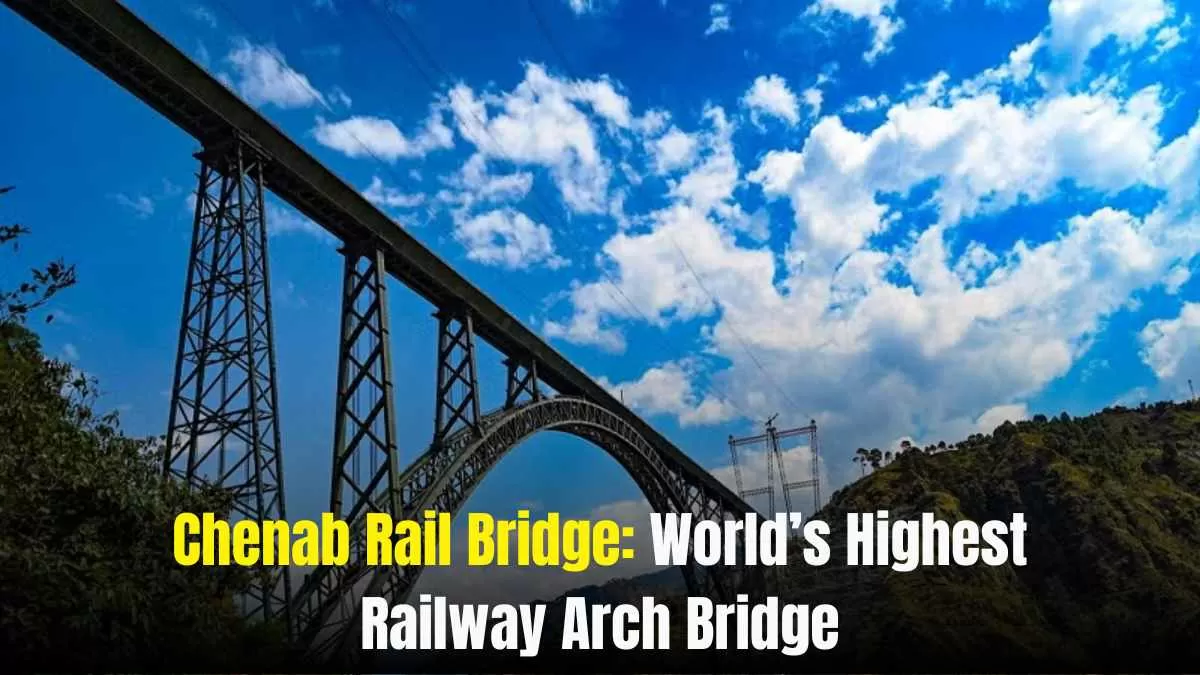The Chenab rail bridge in Jammu and Kashmir is scheduled to be inaugurated by Prime Minister Narendra Modi today, June 6. Additionally, he will also launch two specially built Vande Bharat trains between Katra and Srinagar.
The newly built Chenab rail bridge, which is a component of the 272-kilometer Udhampur-Srinagar-Baramulla Rail Link (USBRL) project, is hailed as the highest railway arch bridge in the world. This bridge might prove to be a game-changer for a country like India. Here's how.
Chenab Bridge: World’s Highest Railway Arch Bridge
Constructed between Bakkal and Kauri in the Reasi district of J&K, the Chenab bridge is 359 meters above the riverbed level and costs roughly Rs 1,400 crore. It is around five times as tall as Qutub Minar and 35 meters higher than the Eiffel Tower in Paris.
The architectural wonder was constructed at Reasi across a ravine of the Chenab Bridge. The world's highest arch bridge is a segment of the USBRL, an all-weather railway line that would connect the Kashmir Valley and Jammu.
Hardships Faced During Its Construction
The Chenab bridge's construction was approved in 2003. However, the region's rugged topography, safety issues, and court proceedings presented a number of difficulties for the bridge's construction.
The main challenge for the engineers while building this bridge was to build it without obstructing the Chenab River's flow.
During the early phases of the infrastructure project's construction, engineers were forced to labor on foot or by mule. Because of the location's inaccessibility and the limited roads, logistics presented still another significant issue. Giridhar Rajagopalan, deputy managing director of Afcons Infrastructure, told a media house that a large number of the bridge's components were constructed and manufactured on location.
Can Tolerate Upto 40 Kg TNT Explosion
The bridge was designed and constructed in a joint venture consisting of VSL India, Ultra Construction & Engineering Company, located in South Korea, and Afcons Infrastructure.
The Chenab bridge has a 120-year lifespan and can withstand earthquakes, high-velocity winds (up to 260 kmph), harsh temperatures, and hydrological effects from rising water levels.
In addition to supporting trains traveling at speeds of up to 100 km/h, the bridge is blast-proof, according to Afcons, which states that it can tolerate high-intensity "explosion of up to 40 kg of TNT." In case of a pillar damaged due to unforeseen circumstances, trains could still operate, albeit at slower speeds.
How will Chenab Bridge Prove to be a Game-changer?
For India, the Chenab railway bridge will constitute a significant strategic advantage. With the construction of this bridge, the Kashmir Valley and the rest of the nation will have all-weather rail connectivity thanks to the Udhampur-Srinagar-Baramulla rail link project.
Previously, the 300-kilometer Srinagar-Jammu national highway served as the sole land route connecting the Valley to the rest of India. However, it frequently has to close during the winter months when snow blocks the roadways. Additionally, landslides would also render the national highway between Jammu and Srinagar inoperable.
The Chenab rail bridge, which is part of this project, will offer a dependable and safe means of traversing the Chenab River, which is vulnerable to landslides and flash floods during monsoon season.
Faster, Safer, and Cheaper: Chenab Rail Bridge Set to Boost Tourism
The opening of the Chenab rail bridge is also significant since it follows the Pahalgam terror attack, which claimed the lives of 26 people, the majority of whom were tourists.
Since then, the J&K administration has worked to boost tourism, which suffered as a result of the April 22 tragedy. A direct rail would be less expensive and take less time to get from Jammu to Srinagar, which would probably boost tourism.
Road travel between Srinagar and Jammu, which typically takes five to six hours, would now just take three to three-and-a-half hours.
